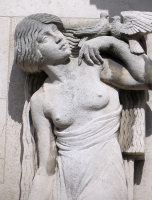
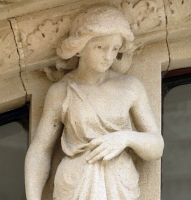
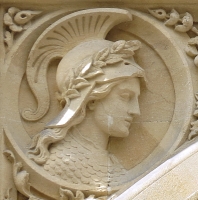
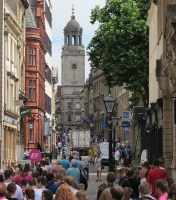
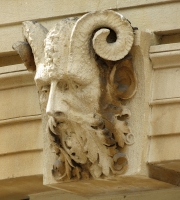
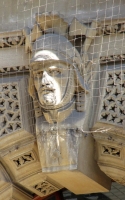
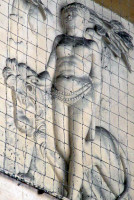
Corn Street is one of the historical streets in central Bristol, and contains much admirable architecture from Georgian to Edwardian times, a considerable portion of which is clad in beautiful warm-coloured Bath stone, with some white Portland Stone. On these buildings is a variety of architectural sculpture of interest to these pages.
Corn Street starts at the Old Council House, opposite Christ Church with St Ewen, and runs south-west, to St Stephen’s Street, where it becomes Clare Street, which runs through to Broad Quay, the natural centre of the city. We start at the top, north east end, where once stood the Bristol High Cross, now in Stourhead (a new 19th Century cross for Bristol, modelled fairly closely on the original, survives in small part, and is described on this page).
The Old Council House, Bristol, with statue of Justice by E.H.Baily.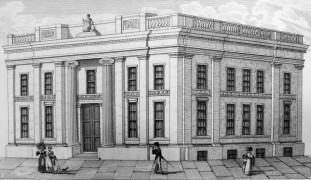
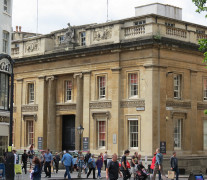
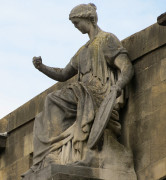
The Old Council House now the Registry Office, stands on the right hand side as we look down Corn Street, on the corner with Broad Street. It was built in the mid-1820s by the architect Robert Smirke, and consists of a rectangular block built in the characteristic yellowish Bath Stone, with five bays on each side, plain flat pilasters between each bay on the front and more on the side to Broad Street, with the middle three bays of the frontage slightly projecting, and the central portico marked by grander attached Ionic pillars. Between the lower and upper storey is a narrow band of repeating carved ornament, and other minor decoration is higher up, but the sculptural interest is on the top, where there is a balustrade with a centrally placed seated female figure flanked by two coats of arms as friezes. The coats of arms (of Bristol and the Royal ones) are rather decayed, but the figure, damaged as it is, retains enough presence and is well-placed enough to be worth notice. She is Classically draped, of course, with a loop of folds around one knee from her heavy skirts, a lighter drape above with short sleeves, and the solid muscularity of arm characteristic of Greek sculpture. In one hand she holds a round or oval shield, the other, raised, has lost the scales she once carried, for she represents Justice. E.H. Baily, one of Bristol’s most eminent sculptors and an important figure on the national stage (he made the Nelson on the column in Trafalgar Square, London, among other notable public works), was the designer of this statue. (For more statues of Justice, see this page.)
Bristol Exchange, by John Wood, 1840-43, and flanking, a Bristol Nail and pedimental coat of arms.
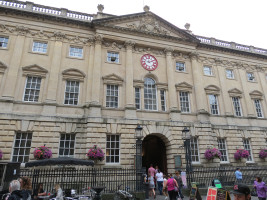
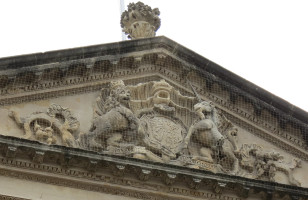
On the opposite side of the street is the Exchange, built to the design of John Wood from 1840-43. In his own description, ‘The North Front [to Corn Street] is of the Corinthian Order upon a rustick Basement: The Center Part breaks forward and makes a Tetrastyle of almost whole Columns, supporting a Pediment, in the Tympan of which the King's Arms are carved in Stone: The Chamber Windows are dress’d with rich Tabernacles; the Attick Windows are square, with Architraves round them, and they rise no higher than the Bottom of the Capitals of the Order: So that the Spaces between the Capitals of the Columns and Pilasters in this Front, are filled with Festoons; which, by representing the four Quarters of the World, with the Products and Manufactures of every Country, points out the Use for which this Building was erected, as well as the Extent of the Commerce of BRISTOL, to all the principal Parts of the World... The Spaces between the Capitals of the Pilasters round the Portico’s of the Place of Exchange, are adorned with Heads and Festoons in Stucco; and the three Quarters of the World, Asia, Africa, and America, are represented in the same Materials over the Doors... The Arch of every Corinthian gate in [the Hall] has a Key Stone, carv’d with a Head, to denote the Business of the Place to which the Aperture under each of those Arches make an Entrance: Mercury’s Head is next the Coffee-House; Bacchus’s Head is next the Tavern; and the Head of the Dea Pecunia of the Antients is next the Place of Exchange...’
Bristol Exchange ornamental sculpture, by Thomas Paty the Elder.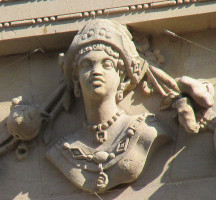
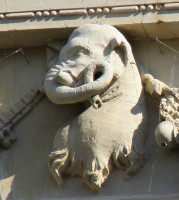
‘Nothing Material is wanted to compleat the Whole [of the North front] but Statues to fill the four and twenty Niches in the Portico’s of the Peristyle; since such Statues will not only contribute to the Ornament of the Place of Exchange, but yield the Curious Matter for Speculation’.
The building included various domes and turrets, ‘all covered with that most excellent and beautiful Material, Mill’d-Lead’. There have been various alternations in the 19th Century and since, but the frontage to Corn Street remains pretty well as Wood designed it, with four tall attached Corinthian pillars supporting a pediment with a large carving of the Royal coat of arms, and beneath, a narrow line of sculptural decoration consisting of the festoons and little heads of people and animals depicting Wood’s scheme of the ‘four Quarters of the World, with the Products and Manufactures of every Country’. Thomas Paty the Elder of Bristol was the sculptor. In front of the building are the four curious metal posts, rather like moulded bird tables, which form the Bristol Nails, where bargains were struck and which are thought to have given rise to the expression ‘to pay on the nail’.
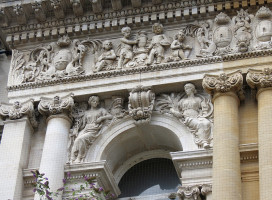 Portion of John Thomas's decorative sculpture on the West of England & S. Wales District Bank.
Portion of John Thomas's decorative sculpture on the West of England & S. Wales District Bank.
On the opposite side, the grand Renaissance Italianate Victorian building with its plethora of sculpture is the former West of England and South Wales District Bank, built by the architects W.B. Gingell and T.R. Lysaght in 1857, and passing to Lloyds Bank at the end of the 19th Century. This building, six bays wide with 22 spandrel girls carved by the sculptor John Thomas, is fully described on this page. The decorated building par excellence in Bristol.
Small Street corner, 49-51 Corn Street.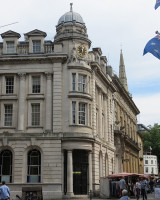
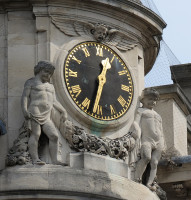
The end of the pedestrianised northern end of Corn Street is marked by Small Street off to the right, and on the corner is 49-51 Corn Street, best seen from a bit further down the street, which is an Edwardian Baroque building with a dome, beneath which is a clock surrounded by figure sculpture: putti or boys to left and right, and a broad-winged cherub head above. The putti hold a festoon of flowers and fruit, extravagantly carved, between them, and hanging down to left and right in the fashion of a cornucopia. The building is late for its type – 1922, the architects being Whinney, Son and Austin Hall.
44 Corn Street, London & Lancashire Insurance, dome and statuary.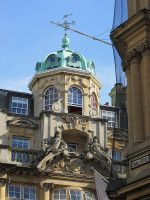
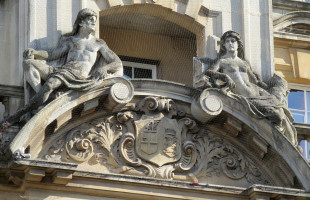
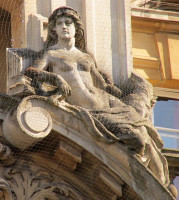
Just past Small Street and now on the left hand side, No. 44 Corn Street is another three bay wide building, with pretensions, for it features a perfect octagonal dome on top, very Edwardian Baroque, with beneath it, a segmental pediment with two reclining figures upon it, carved in pale stone. On the left is a man, nude except a small drapery across his nearer leg, over-muscular and rather simplified in his anatomy, and with a decayed face which has ended up with an unfortunately mulish expression. Upon his raised knee, he holds some rounded object, conceivably a money bag. The nude female figure on the other side is far better, muscular in a feminine fashion, and the face, perhaps restored, is in good condition. She reclines with her elbow propping up a huge book; her other arm holds some indistinguishable object, and her slipped drapery nicely flutters around her legs. The pediment is supported on Ionic two-storey high columns, and one floor down is a frieze of three panels of minor relief carving. The central panel has a variety of flourishes, festoons and foliage framing a central bust of a girl, most symmetrical. London and Lancashire Insurance was the company which put it up in 1904, and the architect was Edward Gabriel.
The Commercial Rooms, 45 Corn Street, and relief panels by the sculptor James Bubb.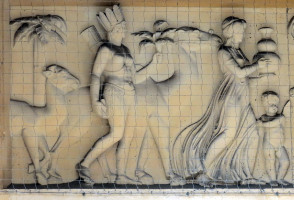
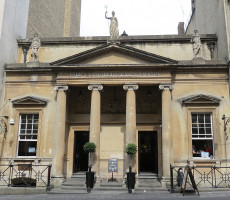
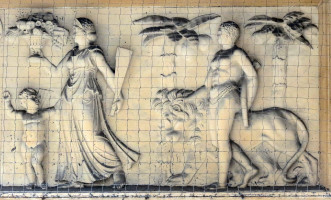
No. 45 Corn Street on the right hand side is the Commercial Rooms, Bristol, and is of sculptural importance. It was put up in 1810-11, becoming at one time ‘the usual resort of the merchants and principal business persons of the city... [with] every facility afforded for obtaining every kind of commercial and political information.... Telegraph messages constantly received, and books of reference, newspapers, &c., regularly supplied.’ The frontage mainly consists of an Ionic portico of four columns, and within this is a bas relief by the sculptor James Bubb, depicting Britannia, Neptune and Minerva receiving tribute from the four quarters of the globe. The central figures, inconveniently obscured today by a light, are the three deities, Britannia seated in the centre, flanked by the other two, sea-horses plunging to the sides, small airborne figures above. The side panels are more characterful. On the left side as we look at them, we see a figure representing America, an almost nude female wearing a native American style feathered headpiece and little else (indicative of America being seen as rather primitive in those times), carrying a plant and a scroll, and bearing a quiver on her back. Behind her walk two camels, and we also see a palmtree, these of course being emblematic of Arabia and the East. In front of her is a nereid-like figure in diaphanous drapery who is likely India, for she has an exotic hairstyle and carries as her tribute a double-bodied pot; a naked cherub stands in front of her. On the other side, we have at the front a conventionally draped figure, perhaps Europe, carrying a bowl overflowing with fruit and flowers, and the rudder of a ship; she too has a cherub accompanying her. And the figure to the far right is certainly identifiable as Africa, a solid-looking African girl wearing only a double string of beads around her waist, carrying a tusk of ivory, and her other hand resting on the mane of a pacing lion. Behind, two palm trees. Very spirited work, and a credit to the sculptor.
Statues of Commerce, Bristol and Navigation in different aspects, by James Bubb.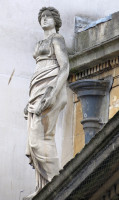
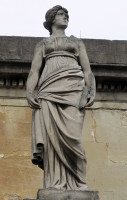

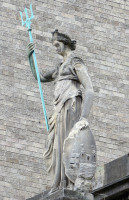
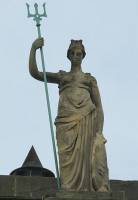
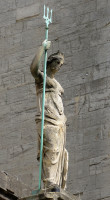
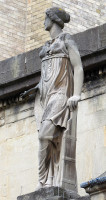
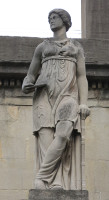
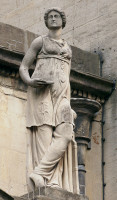
On top of the pediment are standing allegorical statues representing Commerce, Navigation, and the City of Bristol, which I believe also to be by Bubb. They are all rather worn, but still imposing and giving something of what must have been their original appearance. The figure of Bristol is central, rather like a Britannia, holding a short metal trident in one hand, and an oval shield with the City arms in the other. She wears simply delineated but harmonious Classical drapery, symmetrical above, then the skirts hanging aslant to emphasise the raised hip. Navigation stands cross-legged, holding some small implement or booklet, and her identifying emblem, a ship’s rudder. The face is rather ruined, but the arms are still fine, muscular as befits a navigator, and the drapery – light upper, sleeveless garment with buttons to the sides, and trouser-like gathering of drapes over the legs – is good. For more on allegorical sculpture of Navigation, see this page. Commerce has more ambitious drapes, heavily undercut, with a heavy lower drape gathered to one side of the waist, and a lighter upper garment gathered up under the breasts. She carries some scroll, perhaps, and the figure is the better preserved of the three.
Liverpool and London and Globe Insurance Office, 32 Corn Street, .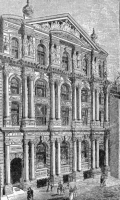
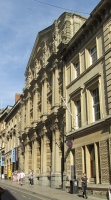
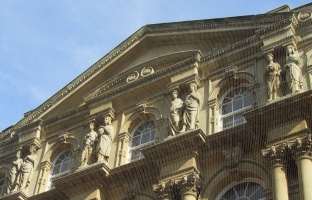
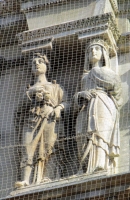
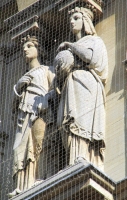
No. 32 Corn Street, back on the left hand side and a few doors further down, now housing a Nat West branch, ‘the Old Bank’, was built as the Bristol branch of the Liverpool and London and Globe Insurance Office. The architect was W. B. Gingell, whose work we have already met. The frontage (behind, all has been replaced) is another Italianate building in the grandest style: five bays wide, it has coupled pairs of Corinthian columns between each bay, repeated above the ground floor with a second set rising two further storeys, and then with a further storey where the columns are replaced by pairs of standing figures acting as Caryatids. The pediment supported above, planned originally to contain further figural sculpture (see picture above left), is empty, save for a small rounded mini-pediment with carved scrolling. The female figures are too high and the street too narrow to properly gauge their iconography, but include one with a globe, another with fruit, and one with a book, so are likely connected with the areas of insurance of the company – the globe at least reflects the name of the institution. The ground floor has keystones showing firemen’s heads with axes behind them (see picture at top of page, 2nd right), and an elderly bearded man with winged helm (see this page for keystone bearded heads). According to the erudite folk at the PMSA, the sculptor was Thomas Colley, of Stokes Croft, Bristol, not a familiar figure to me.
Hermon Cawthra's semi-nude art deco figure groups for 37-39 Corn Street.
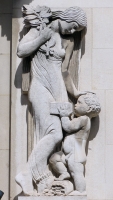
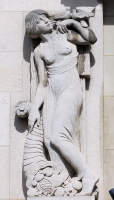
Nos.37-39 Corn Street, on the right hand side almost opposite No.32, is three bays wide on the ground floor with the central bay wide enough that the upper floors fit four bays in all, and was erected for an insurance company, Friends Provident. It is a dull, flat-faced block with a mean and unsupported pediment above the fourth storey: Roques and Giles Gilbert Scott were the architects. However, it is notable for its figure sculpture, consisting of a pair of semi-nude figure groups above and either side of the portico, charming creatures of the Art Deco period. She on the left as we look at the building stands in an exaggerated contrapuncto pose, her body and limbs also turning, so that the feet face left, her thighs in three-quarters view, her breasts towards us and head turned to face the other way, emphasising the flexibility of the girlish figure. She is looking at a pair of doves alighted on her raised hand and wrist, and her other hand holds a large cornucopia, thus Peace and Plenty. How very 1930s she is, with her wavy hair, slender figure, and the design of the doves and the stylised form of the pomegranate falling from the cornucopia – the face, however, could have been from two decades earlier. The second figure group, entitled Benevolence and Prudence, has the matching girl, again with an S-shaped pose, but here more restful, head downward turned to gaze at the plump naked cherub or putto representing Prudence, who holds up a collection box while one fat little leg is raised to place the foot on a moneybag; a second bag in relief has a £ sign helpfully inscribed upon it. Benevolence is symbolised by the girl holding an olive branch in one hand, and the other resting, benevolently, on the forehead of the putto. Hermon Cawthra was the sculptor, and these figures are typical of his style.
31 Corn Street, by W.B.Gingell, and sculptural decoration.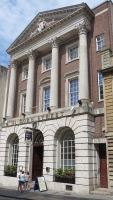
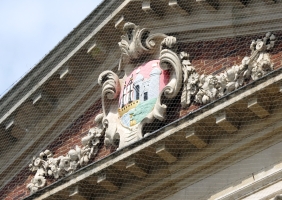
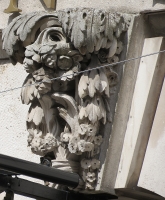
Continuing, 31 Corn Street on the same side is another banking building, built by W.B.Gingell again, dating from the 1860s. The building is faced with another grand portico, three bays wide, with arched central door and two arched windows on the ground floor, and four Corinthian pillars rising from above this floor, two storeys high, to support entablature and pediment, enclosing the City Arms on a cartouche, with two decoratively carved festoons of flowers; the only ornament lower down is an elaborately carved keystone over the central doorway with flowers and droopy leaves. (If you like keystones, see this page.)
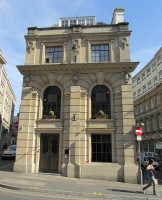
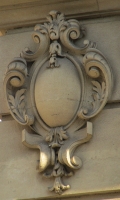 Building between St Nicholas Street and St Stephen's Street, and architectural cartouche.
Building between St Nicholas Street and St Stephen's Street, and architectural cartouche.
The narrow space between St Nicholas Street and St Stephen’s Street on the left hand side allows for a blocky building of stone just two bays wide which contains simple but elegant cartouches above the second floor; and this marks the end of Corn Street proper, after which the road continues as Clare Street.
28 Clare Street, Caryatid, Atlantes and decorative figures.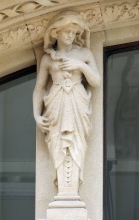
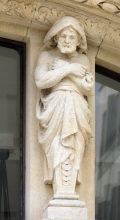
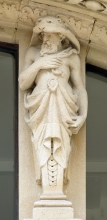
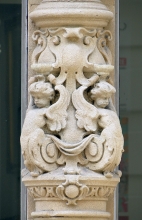
On the south side of the entrance to St Stephen’s Street the corner building, 28 Clare Street, has further figural sculpture, in the form of six small figures acting as caryatids at the tops of the principal windows, two on the Clare Street side, four facing St Stephen’s Street. Caryatids are in place of pillars (see this page for lots of examples), and these are half-figures, thus human at the top, architectural at the bottom. There is always an issue over how to make the transition from body to stonework, and here it is done by giving each girlish figure a skirt, clasped at the waist, then hanging down, and although we see the swell of the hip and thigh, what emerges down below is a pillar. There are male figures too (Atlantes), with drapes, and while the overall height of each column is proportionate for a human figure counting the base, there is a small issue with those figures with arms by their sides, as they have been made the same length for both sexes, which makes the female arms look a little long (as a man’s hand hangs to mid-thigh and a woman’s not so far down). The figures are of merit, particularly that of Hercules, with a lionskin over his head. There is much minor sculptural decoration in relief, on the shafts of the columns, on the capitals, and generally around the windows – we see grotesque cherubic figures, heads, and floral designs. On the extra two bays along St Stephen’s Street is a Satyr’s head as a keystone (see top of page), and relief roundels with portraits of Athena and Mercury (see this page for keystone sculpture, and this page for Satyr sculpture).
On the opposite corner of Clare Street is nos. 25-27 Clare Street, another Edwardian Baroque building without sculpture, but a charming dome, built for the Scottish Provident Building Society in 1903, the architects being Oatley and Lawrence.
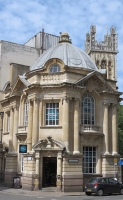
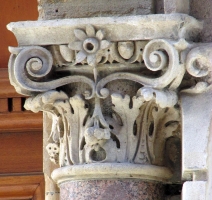
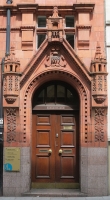 No. 25-27 Clare Street: No. 25-27, capital to No. 25, doorway to no. 17-19.
No. 25-27 Clare Street: No. 25-27, capital to No. 25, doorway to no. 17-19.
Proceeding, no.24 Clare Street is a Gothic intrusion on the Classical street, at least so far as the ground floor arches go. It is three narrow bays wide, and has minor sculptural decoration, notably the richly carved floral designs on the capitals of the pillars (for more pillar sculpture, see this page). The date AD 1714 is inscribed above the first floor, which would refer to the foundation of the institution housed there at one time, for the building is indubitably Victorian.
Diagonally opposite that, on the corner of St Stephen Avenue, is a blood-red terra cotta spiky Victorian Gothic building dated 1899, which is no surprise to find is the Prudential Assurance Building, 17-19 Clare Street, by the architect Alfred Waterhouse in his typical style and favourite colour. A bit naughty to place this among the pale Bath stone and Portland stone buildings of one of Bristol’s most historic streets, but Waterhouse never worried about things like that, and his building, as ever, is excellent enough to hold its own.
We have an excellent vista of the tall tower of St Stephen’s Parish Church a few paces down St Stephen Avenue – and this church and its significant funereal monuments are described on this page.
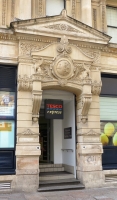
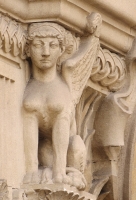 4-6 CLare Street: portico and a sphinx.
4-6 CLare Street: portico and a sphinx.
The last, short portion of Clare Street is once more pedestrianised, as when we started our walk at the top of Corn Street. The Tesco, Abbey Chambers, No. 4-8 Clare Street, has a fine doorway, enriched with carving. This includes a central cartouche and a pair of small sphinxes to the sides – see this page if you like sphinx sculpture.
2 Clare Street, Glass & Co, and sculptural details.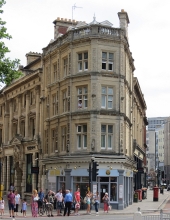

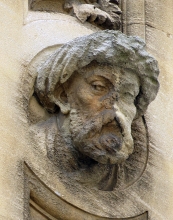
At the very end of Clare Street, the building on the sharp corner to Baldwin Street, is No. 2 Clare Street, built for Glass & Co. in 1881, to the designs of the architect C.F.Hansom. Glass & Co were importers of tobacco, and this accounts for the odd mix of figure sculpture: Walter Raleigh, an American Indian, some further very damaged figure, and busts including Raleigh and an African man presumably indicative of the tobacco farms. The sculptor was apparently a certain Sheppard of Paul Street, St Pauls, Bristol – not a familiar name to me at all.
And thus ends this sculptural walk: a continuation on this site is a walk along nearby Broad Quay.
Sculpture in some towns in England
Visits to this page from 26 April 2015: 1,947 since 10 September 2024